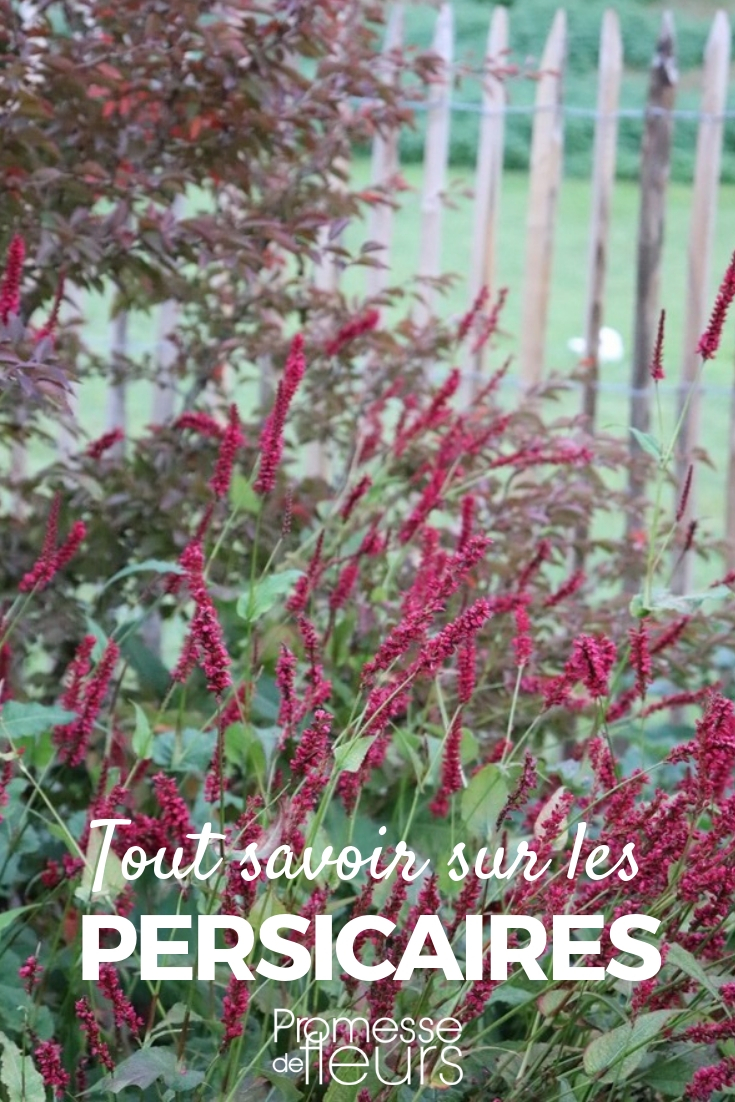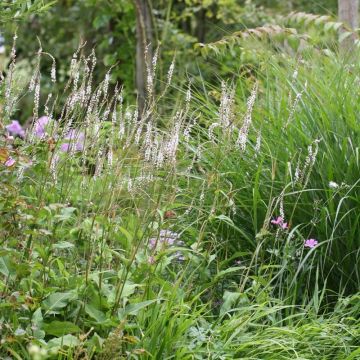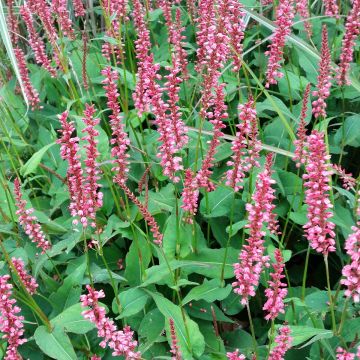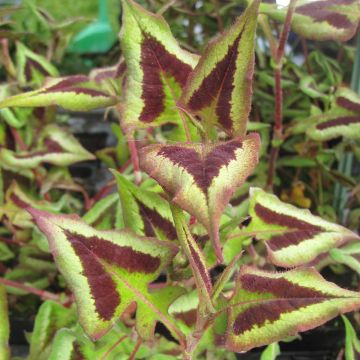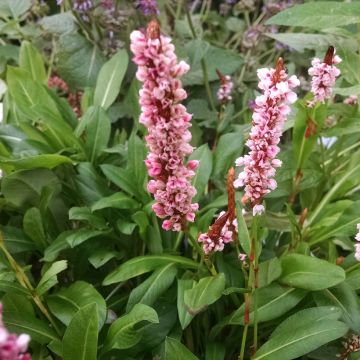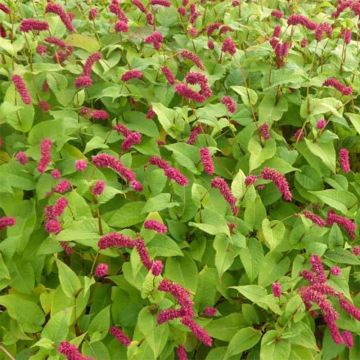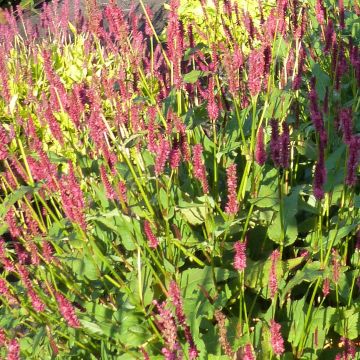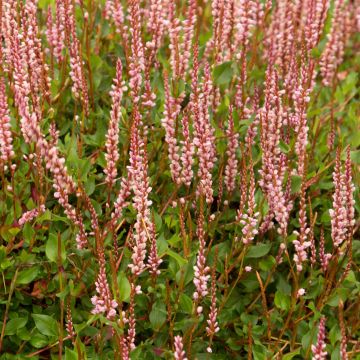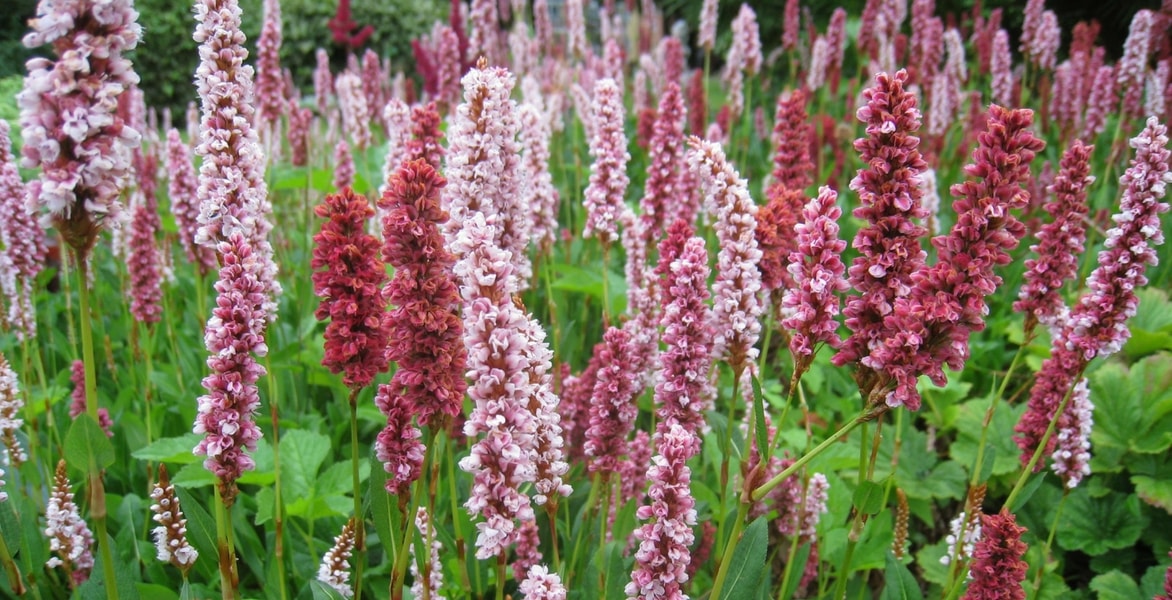
Persicarias or Knotweeds: planting, cultivation and maintenance
Contents
Persicarias in a nutshell
- The Persicaria or Knotweed offers a very long and beautiful flowering period, bringing lightness and structure to your borders from the beginning of summer and for four months!
- Planted alongside grasses, it allows for the creation of stunning contemporary gardens or naturalistic borders, reminiscent of natural meadows.
- Sometimes confused with invasive plants, the Persicaria poses little risk and is easily managed.
- Thriving in cool soil, it quickly flourishes and requires very little maintenance.
- Very vigorous and bushy, its dense foliage helps to smother weeds! It can thus be used as a flowering ground cover even in challenging or shaded areas.
- There are many varieties: discover the very fine and delicate inflorescences of Persicaria filiformis, the intense red flowering of Persicaria amplexicaulis ‘Blackfield’, and the surprising purple foliage of Persicaria ‘Red Dragon’!
A word from our Expert
Also known as Knotweed and Polygonum, Persicaria is a stunning perennial that will delight you with its long and generous flowering. From July onwards, it is covered in countless spikes of flowers, in pastel shades (pink, white) or red, which last until the first frosts. Its very fine inflorescences, borne on tall stems, will give a wild look to your garden. It pairs wonderfully with grasses to create contemporary or natural gardens. It brings lightness and elegance to your flower beds. Among the most well-known varieties, Persicaria amplexicaulis ‘Blackfield’ stands out for its intense red flowering.
Some varieties feature very decorative foliage, such as Persicaria ‘Red Dragon’, which will charm you with its surprising purple leaves marked with silver white. Persicaria ‘Purple Fantasy’ features a magnificent triangular foliage that is very contrasting and graphic. Most species have an upright habit, but some are spreading, such as Persicaria affinis, and can be used as ground cover to effectively limit the growth of weeds.
Once well established, in full sun or partial shade, in cool or even moist soil, Persicaria is particularly vigorous. Hardy, it requires little maintenance and is relatively resistant to diseases and pests.
Botany
Botanical data
- Latin name ”Latin
- Common name ”Common
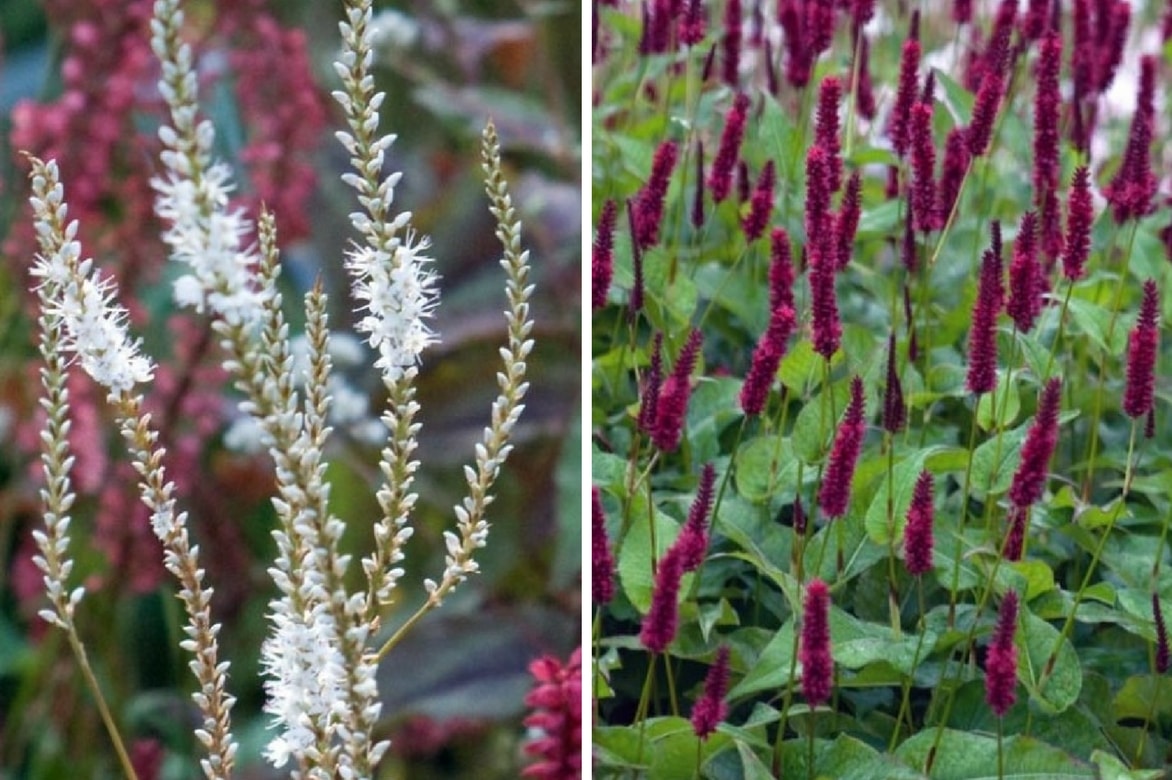 Persicaria amplexicaulis ‘Alba’ and Persicaria amplexicaulis ‘Blackfield’[/caption]
Persicaria amplexicaulis ‘Alba’ and Persicaria amplexicaulis ‘Blackfield’[/caption]
The Persicaria offers a generous flowering, lasting a long time: from early summer (June-July) until the first frosts. The plant becomes covered with a multitude of white, pink, or red flowers, grouped in often very fine and elongated spikes. They are perched at the tips of long stems, giving the whole a lot of graphic quality and finesse. These spikes are composed of small five-petalled flowers.
The flowering of some species deviates from this rule. For instance, Persicaria runcinata is one of the few Persicarias to offer short, rounded spikes. The Persicaria orientalis, on the other hand, has spikes that are not upright but pendulous. And the inflorescence of Persicaria polymorpha, in a loose and airy panicle, strongly resembles that of Astilbes!
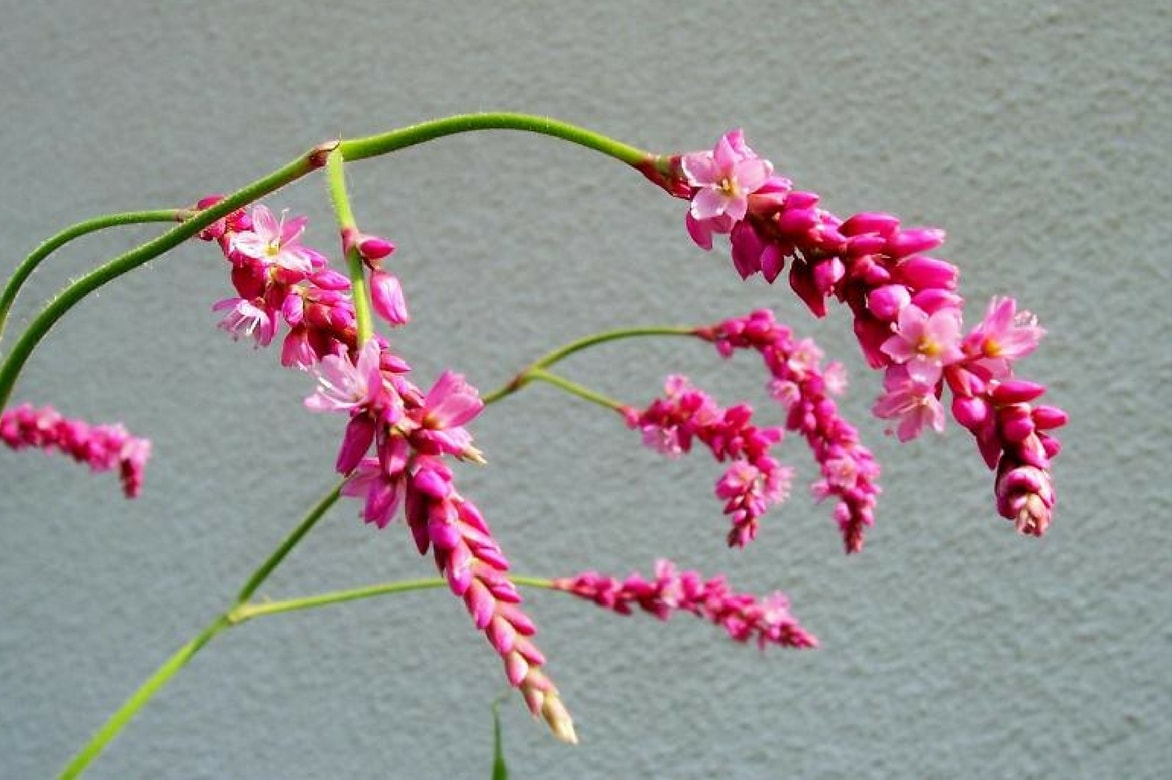
Persicaria orientalis
The leaves of Persicarias are often entire, with smooth edges and finely pointed tips. They can take on remarkable red hues in autumn. Most species are deciduous, losing their leaves in autumn. But some are semi-evergreen, like Persicaria campanulata.
Their leaves can sometimes be very beautiful and original! One will notice the triangular and highly contrasting foliage of Persicaria ‘Purple Fantasy’ and Persicaria microcephala ‘Red Dragon’ (dark red), as well as the variegated green and cream-white leaves of Persicaria virginiana ‘Painter’s Palette’.

Knotweed Persicaria, very decorative foliage: Persicaria filiformis / Persicaria virginiana ‘Painter’s Palette’ / Persicaria ‘Purple Fantasy’ / Persicaria microcephala
Very vigorous, the Persicaria spreads quickly thanks to its rhizomes (horizontal underground stems). This allows it to establish well and makes some species potentially invasive. Fibrous roots develop on these rhizomes.
Some species are useful, edible, or medicinal plants. For instance, Persicaria odorata is used in Asian cuisine, known as Rau ram or Vietnamese mint. As for Persicaria tinctoria, the Indigo Knotweed, it is used in Asia to extract indigo dye.
The main species of Persicaria
There are around a hundred botanical species of Persicaria, as well as numerous varieties. The botanicals are commonly cultivated in gardens.
- Persicaria amplexicaulis
The stem-clasping Persicaria is a robust and non-invasive species. Native to the wetlands of the Himalayas, it can grow with its feet in water, yet it withstands brief summer droughts. It thrives in heavy, clayey soils and will do well at the edge of woodlands. It produces tall stems and bears very beautiful semi-evergreen leaves. Its flowers, grouped in spikes, are pink, red, or white. They give it a wild appearance, making it suitable for naturalistic gardens. It is very hardy, down to -25 °C.
- Persicaria affinis
Like Persicaria amplexicaulis, it originates from the Himalayas. This is a spreading species, relatively low, but it spreads easily. It flowers in dense spikes, pale pink to rose-red. Its lanceolate leaves turn red-bronze in autumn. Tolerating both drought and sun, it will thrive if you plant it in a rockery. You can also plant it in pots or as a border.
- Persicaria filiformis
This species forms compact clumps and has very beautiful green foliage speckled with brown. This is deciduous. It gets its name from its very long, thread-like flower spikes, which bear small red flowers. It is also found under the name Persicaria virginiana var. filiformis.
- Persicaria bistorta
The bistort Persicaria grows quickly and bears pale pink flower spikes. It is found naturally in Europe, Asia, and North America, primarily in wet mountain meadows and along riverbanks. It therefore requires relatively moist soil and will thrive at the edge of a pond, in cool, clayey soil. It is often marketed under the very beautiful variety Persicaria bistorta ‘Superba’.
This is a species to discover, still too little known! It bears panicles of delicate pale pink bell-shaped flowers. Its leaves, white on the underside, have very pronounced veins, making them particularly decorative. It spreads through its stolons, forming large colonies at the edge of woodlands. It requires moisture to thrive.
This is a small species, originating from Japanese forests and woodlands. Its habit is spreading and it forms compact tussocks. It will thrive in a rockery. It flowers early in spring and then bears small spikes of white flowers.
The polymorphous knotweed eventually forms a huge clump that can reach 2 m in height. In summer, it offers stunning white corymb flowers that attract insects and butterflies. Discover it in video:
Discover other Persicaria - Knotweed
View all →Available in 1 sizes
Available in 1 sizes
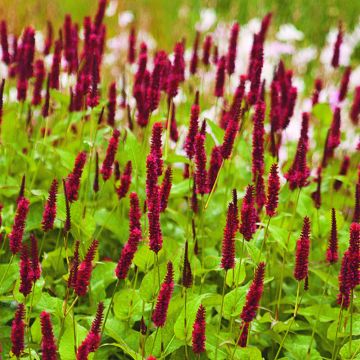
Available in 2 sizes
Available in 1 sizes
Available in 2 sizes
Available in 2 sizes
Available in 2 sizes
Available in 1 sizes
Available in 1 sizes
Available in 2 sizes
The main varieties

Persicaria amplexicaulis Blackfield - Mountain Fleece
- Flowering time August to November
- Height at maturity 80 cm
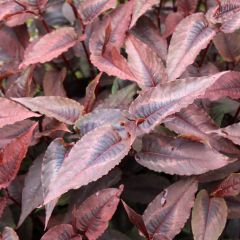
Persicaria microcephala Red Dragon - Knotweed
- Flowering time August, September
- Height at maturity 80 cm
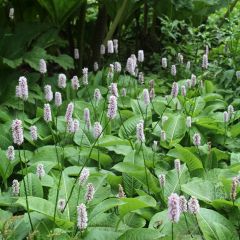
Persicaria bistorta Superba - Bistort
- Flowering time June, July
- Height at maturity 60 cm
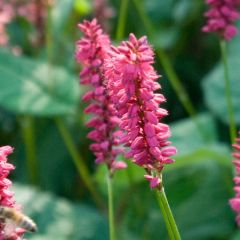
Persicaria amplexicaulis Taurus - Mountain Fleece
- Flowering time August to October
- Height at maturity 1 m

Persicaria campanulata
- Flowering time August to November
- Height at maturity 1,20 m
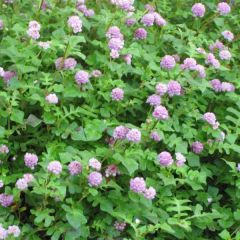
Persicaria runcinata Needhams Form - Knotweed
- Flowering time August to December
- Height at maturity 15 cm

Persicaria amplexicaulis Pink Elephant - Mountain Fleece
- Flowering time July to December
- Height at maturity 40 cm

Persicaria runcinata Purple Fantasy - Knotweed
- Flowering time August to November
- Height at maturity 50 cm

Persicaria amplexicaulis High Society - Mountain Fleece
- Flowering time August to November
- Height at maturity 1,20 m

Persicaria virginiana var. filiformis - Virginia Knotweed
- Flowering time September to December
- Height at maturity 50 cm
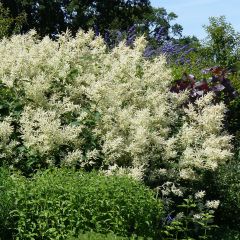
Persicaria polymorpha - Knotweed
- Flowering time July to November
- Height at maturity 2 m

Persicaria virginiana Painters Palette - Virginia Knotweed
- Flowering time September, October
- Height at maturity 60 cm
Planting Persicaria
Where to plant the Persicaria?
Plant it in full sun or partial shade, in a sheltered position from the wind. You can place it at the edge of a woodland. Small Persicarias, such as Persicaria tenuicaulis, thrive in the shade. The majority of species prefer rich, heavy clay soils. If your soil is poor, you can improve it by incorporating compost. However, the most important factor is that the soil remains cool, even moist. Some Persicarias naturally grow on the banks of streams or water bodies, so they will do well by a pond. If planted in a dry location, they may not flower and will develop less easily.
The foliage of Persicaria microcephala ‘Red Dragon’ takes on more vibrant colours when planted in the shade.
Vigorous, Persicarias spread easily: give them enough space to develop properly (especially if you are installing a rhizome barrier!). Avoid placing them in a bed that is too narrow.
Follow these tips to install a rhizome barrier.
Persicaria affinis ‘Darjeeling Red’, Persicaria tenuicaulis, and Persicaria vaccinifolia can be planted in a rockery, provided it is not too dry.
When to plant?
It is best to plant the Persicaria in autumn, in September-October, to allow the roots to establish well before winter. Spring planting, from April onwards, is also possible, provided you water well during the first few weeks to encourage rooting.
How to plant?
We recommend maintaining a planting distance of 50 to 60 cm between each plant.
- Start by moistening the root ball by soaking it in a basin filled with water. This will increase the chances of successful establishment.
- Prepare the ground by working the soil to a depth of 30 to 40 cm.
- If necessary, place a rhizome barrier.
- Dig a planting hole about twice the size of the root ball.
- Fill the bottom of the hole with soil. We also recommend adding compost, as the Persicaria prefers rich soil.
- Place the plant so that the top of the root ball is level with the soil.
- Replace the soil around the root ball, then gently firm it down with the palm of your hand.
- Water generously.
- Continue to water regularly in the weeks following planting.
If you are planting Persicaria runcinata, Persicaria elata, or Persicaria polystachyum, install a rhizome barrier. You can also divide them after a few years to better control their growth. If it is Persicaria polymorpha, Persicaria amplexicaulis, or Persicaria tenuicaulis, there is no need for concern as these species are not invasive.
Once well established in cool soil, the Persicaria grows quickly. It can live for several years without requiring special attention.
How to care for Persicaria?
Once well established, the smartweed requires very little maintenance. Robust and resilient, it is not very susceptible to diseases and parasitic threats. Only snails and slugs may occasionally nibble on its foliage, especially in spring when the young shoots are tender. A simple regular check for these pests is usually enough to protect the plant.
It is important to water in case of prolonged drought, as the smartweed prefers the soil to remain moist. Mulching around the base can help retain moisture.
To prolong the flowering, regularly cut back the faded flowers, which will encourage the plant to produce new flowering shoots. In autumn, cut back the clump to promote a more vigorous regrowth the following spring.
Over the years, when the clump becomes very dense, it is advisable to divide the rootstocks to rejuvenate the plant and give it more space to grow. If your smartweeds become too invasive, do not hesitate to divide them to limit their spread.
When handling smartweeds, remember to wear gloves, as their sap can be slightly irritating to the skin. With these few simple steps, your smartweed will continue to enhance your garden without requiring too much effort!
How to propagate it?
Some Persicarias can self-seed spontaneously, particularly Persicaria orientalis and Persicaria virginiana. Thus, Persicaria orientalis tends to self-seed abundantly in autumn. As it is an annual species, it can persist in the garden. To propagate Persicaria, we recommend rhizome division rather than propagation by cuttings. You will obtain a bushier and more flowering plant much more quickly.
Rhizome Division
You can easily multiply Persicarias by dividing their rhizomes in spring or autumn. This not only allows you to obtain new plants but also helps to limit the growth of those already in place, which can sometimes be a bit too vigorous. By dividing the rhizomes and replanting them, you will gradually cover large areas and thus beautify part of your garden.
- Start by digging up the stump with a spade.
- Remove the excess soil attached to the rhizomes by gently shaking the stump.
- Separate the rhizomes using a knife, ensuring to keep some roots for each new plant.
- If necessary, shorten the stems or remove some leaves to balance the root and aerial parts.
- Place each rhizome in a pot filled with potting soil.
- Water generously.
- All that’s left is to place the pot in a sheltered spot.
Propagation by Cuttings
Persicaria is a very easy plant to propagate by cuttings. Act in spring, between May and July.
- Start by preparing a pot by filling it with substrate and moistening it.
- Take a piece of stem about ten cm long. Cut it cleanly with a knife, just before a node (the point where a leaf attaches to the stem).
- Optionally remove one or two basal leaves.
- Make a hole in the pot with a stick.
- Place the cutting in the hole.
- Gently firm the soil around the stem.
- Keep the pot in a sheltered location, in a bright and warm spot, and ensure the substrate remains moist.
How to pair Persicaria?
With its light and delicate flowering, Persicaria is ideal for creating naturalistic borders. Its soft and airy habit allows for the creation of scenes reminiscent of wild meadows, when combined with grasses such as Miscanthus or Stipa, which add movement and texture. These combinations evoke natural landscapes, balancing lightness and structure, perfect for modern gardens seeking a spontaneous and fluid appearance.
Persicaria is not solely reserved for naturalistic gardens. Thanks to its verticality and free habit, it also integrates perfectly into contemporary and graphic gardens. It can provide a striking contrast when paired with plants that have more rigid forms, such as topiary boxwoods or conifers with strict lines. This opposition between the free forms of Persicaria and the geometric outlines of other plants adds a touch of originality and modernity. Try pairing it with trimmed hedges or plant sculptures to create sophisticated scenes.
In another context, Persicaria also thrives at the edge of woodlands. It will bring light and contrast when planted near lush foliage such as that of Hostas or Japanese Anemones. These combinations allow for subtle contrasts between foliage and flowers, with a harmony of soft hues and a play of textures.
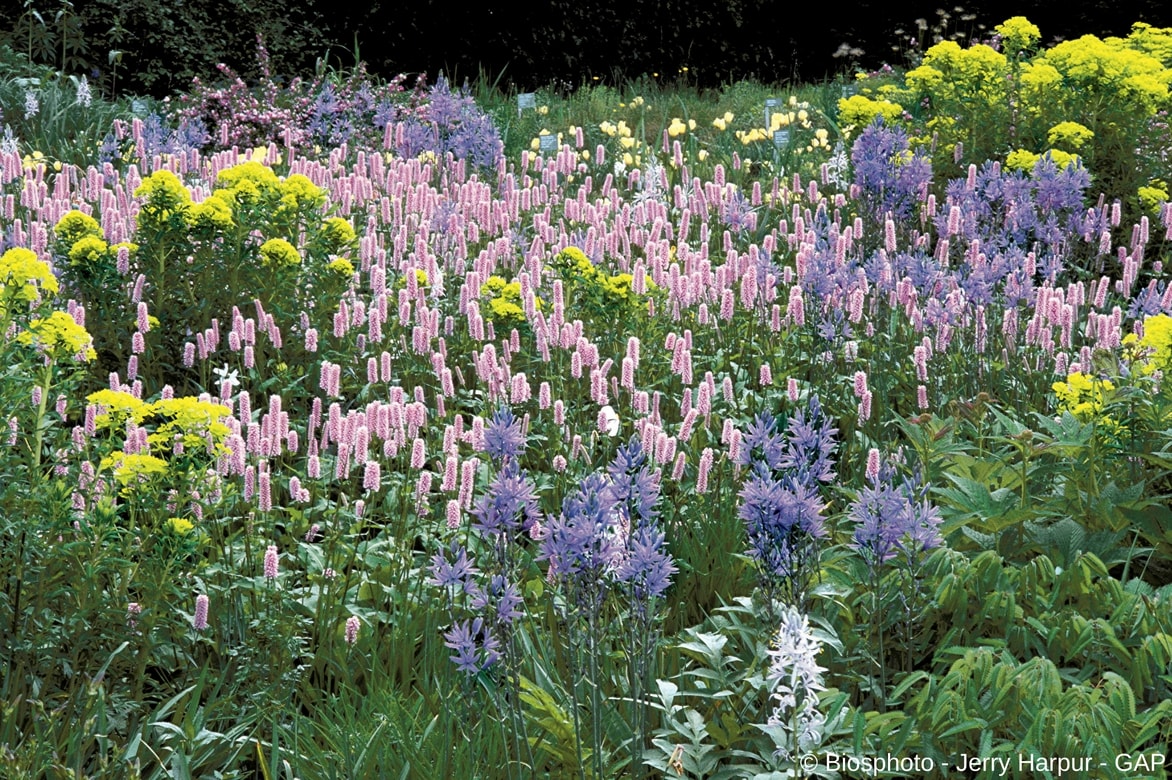
Persicaria bistorta ‘Superba’ – Euphorbia palustris – Camassia leichtlinii ‘Caerulea’
With its majestic and lush habit, Persicaria polymorpha naturally finds its place in exotic gardens. Pair it with hardy palms, giant-leaved Gunneras, or tree ferns to enhance this lush and exotic feel. Its large inflorescences create imposing volumes that add a spectacular note to exuberant compositions.
Other varieties, such as Persicaria runcinata ‘Purple Fantasy’ or Persicaria microcephala ‘Red Dragon’, are particularly prized for their decorative foliage. The purple-marked foliage of the ‘Red Dragon’ variety beautifully complements the dark flowering of Geranium phaeum, creating a strong graphic effect and striking colour plays. These Persicarias are perfect for those looking to add contrast and originality to their borders while playing with deep shades and intriguing textures.
Also, discover our best marriage ideas in our advice sheet: “Persicarias or Knotweeds: 10 Successful Association Ideas”
Useful resources
- Our wide range of Persicarias on our site.
- Our advice sheets: Choosing a persicaria, 7 persicarias with white flowers, 7 persicarias with red flowers, 7 persicarias with pink flowers
- Subscribe!
- Contents
